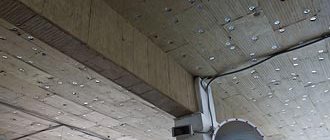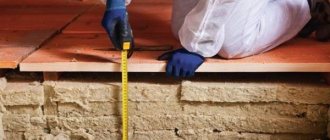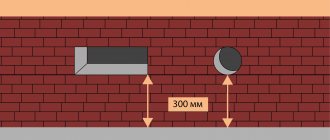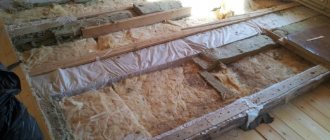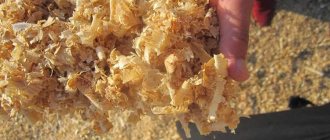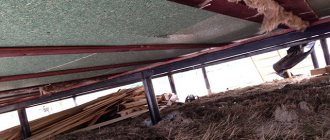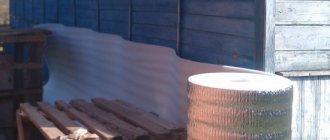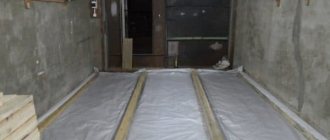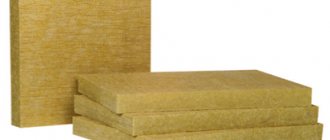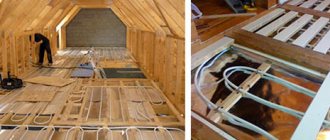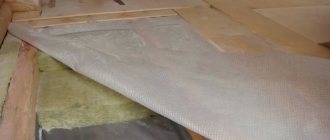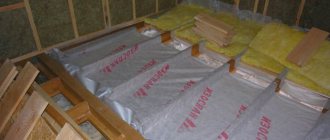Everyone knows and remembers why waterproofing is needed, but they often forget that the floor also needs to be protected from water vapor. But in vain. It is the fumes that often cause damage to the floor covering. If, when opening the floor, fungus, mold and other problems are discovered, most likely the reason is that the cake was not protected from steam penetration. Izospan brand materials can be used as a steam-hydrobarrier. This is a Russian manufacturer that has been on the market for a long time and produces vapor-waterproofing films and membranes. To choose Izospan for the floor you need to know exactly what type you need in a particular cake.
Types of vapor barrier materials
In construction, various materials are used for waterproofing and vapor barrier:
- polyethylene and polypropylene film;
- breathable (diffuse) membranes;
- bitumen mastics;
- liquid rubber.
The last two types are suitable for concrete surfaces and are not used on wooden structures. Each of the listed types of waterproofing and vapor barrier has its own characteristics.
The most common and budget option for vapor barrier is polyethylene sheet. It comes in different thicknesses. Consists of 1-2 layers.
Manufacturers produce perforated and non-perforated polyethylene film. The first is used for waterproofing. It contains micro-holes with a higher degree of vapor permeability (Sd=1...2 m). In non-perforated products this indicator is lower (Sd=40...80 m). Because of this, it is used as a vapor barrier.
Modern development of polyethylene films for hydro- and vapor barriers - products with reflective aluminum coating. The vapor barrier ability of this type is higher than traditional samples. It is used to protect plank floors in rooms with elevated air temperatures and humidity exceeding optimal parameters: in kitchens. In bathrooms, saunas, baths.
The main disadvantage of polyethylene sheets is low strength. Any impact will cause them to break.
They are mounted with extreme caution, trying to avoid sharp corners and strong tensions. They have a short shelf life
A more durable and wear-resistant artificial material is propylene. It is similar to the previous option, but surpasses it in quality and performance characteristics when used as a hydro- and vapor barrier product for a wooden floor.
Polypropylene reinforced fabrics, in addition to the main synthetic layer, have a viscose-cellulose insert. It is she who absorbs a large amount of liquid and holds it to prevent the formation of drops. When the air temperature rises, the humidity level drops, and this layer dries out. To make the process happen faster, an effective ventilation system is created.
The main advantage of polypropylene products is a high degree of resistance to any weather conditions. They are strong and durable, affordable and quite easy to install. When using polypropylene sheets for hydro- and vapor barrier, the anti-condensation layer is turned towards the rough flooring boards. A ventilation gap is created between the insulation mats and the film.
The most expensive material for hydro-vapor barrier is breathable (diffuse) membranes. These are high-quality modern products with a high coefficient of vapor permeability. They have a special microstructure. The basis of this material is a non-woven fabric woven from synthetic fibers.
Breathable membranes come in 1-2-3 layers. They contain a special anti-condensation layer in which moisture accumulates and then evaporates. Multilayer products include smart membranes. They combine the properties of hydro-, heat- and vapor barrier, and have the ability to independently regulate steam exchange depending on the level of humidity and temperature.
A serious advantage of breathable membranes is the possibility of using them without a ventilation device. This property allows you to save space on the floor by making the ceiling higher. When using these products, there is no need to install additional insulation.
Diffuse membranes are a durable, wear-resistant material that reliably protects boards from moisture. It is expensive, but has a long shelf life and is easier to install.
To choose the right material for vapor barrier of a wooden floor, you should correlate the structural features, the design of the rough and final coating, and financial capabilities.
The purpose of vapor barrier work
Wooden structures are very susceptible to moisture. This can cause the wood to swell and warp. The floor is an area that can come into contact with moisture on both sides. Soil moisture, as well as the constantly changing microclimate of the room, negatively affects the floor of the building.
In kitchens and bathrooms, water can often spill on the floor, although the humidity in these rooms is always high. This two-way bombardment of moisture can very quickly destroy the foundation or lead to the appearance of mold or mildew in the house.
In view of this, it is advisable to hydro and vapor barrier the floor in a wooden house. Thanks to such building material as Izospan for flooring, it is possible to qualitatively protect wood from moisture and condensation.
Vapor barrier for floors in a wooden house - a detailed description of the work process
Glassine. It is paper impregnated with a bitumen-based composition. This option is distinguished by its low price, but its reliability and durability raise questions. The use of this type of product is not recommended.
Polyethylene film. The standard version is often used for vapor barrier of the floor. But this type of product is not very suitable for wooden structures, since it does not allow evaporation and condensation can form inside the cavity, which is extremely undesirable.
Polypropylene film. This option is best suited as it combines reasonable cost and high performance properties.
One of the most popular brands is Izospan B - this type of product is ideal for flooring in a wooden house.
The cost of a roll of 70 square meters is approximately 1000 rubles.
Vapor barrier membrane made of non-woven material. This version of perforated film has a two or even three-layer structure.
It has excellent vapor permeability, which is very important when used in wooden structures. The only negative is the high price of vapor barrier material
The membrane will cost you 3-4 times more than the same Izospan
The only negative is the high price of the vapor barrier material. The membrane will cost you 3-4 times more than the same Izospan.
Which vapor barrier to choose is up to you. Personally, I recommend Izospan - it is perfect for the floor in a wooden house.
Below we describe in detail how to use Izospan and other materials for vapor barrier
In addition to vapor barrier, other materials are needed:
Special double-sided tape. Most often it is sold together with insulating material and is intended for reliable connection of sheets. The amount of tape is determined by the length of the joints that will be on the floor. In addition to connecting the rolls, you need to glue the tape around the perimeter of the walls to fix the film on the surface;
A special tape allows you to securely connect the edges of the vapor barrier film
Mineral wool. It is laid on the bottom layer of vapor barrier; the layer of material depends on the requirements for insulation and can be from 5 to 20 cm. You can use either a roll or sheet version;
Mineral wool is an ideal insulation for wooden floors
Wooden slats. Needed to construct a counter-lattice on top of a vapor barrier film. The thickness of the elements must be at least 30 mm to create a ventilation gap, and the width can be any, most often it is 40-50 mm;
Choose a dry wooden strip so that it does not crack after installation
Fasteners To attach the slats, you need wood screws 50-60 mm long. And to fix the membrane, you cannot do without special staples 6-8 mm long. It is better to choose the hardened version, as it is much stronger and drives perfectly even into hard, dry wood.
The staples make it very easy to attach the film.
Tool
To do the work yourself, you will need the following tool:
Screwdriver. It is used to make rough flooring when preparing the surface. The tool is also used when installing counter-lattice on top of the vapor barrier layer. The kit should contain nozzles of the required configuration for tightening screws;
A screwdriver is an indispensable tool for construction work.
Construction stapler. With its help, the installation of the vapor barrier layer will take place very quickly.
This way you can securely fix the material without damaging it, which is very important when installing the film;
A construction stapler greatly simplifies the process of attaching film to wooden structures.
Scissors or construction knife. Used for cutting film. There is not much difference, use what is more convenient for you;
Scissors allow you to quickly and efficiently cut any film
- Measuring tool. To work, you will need a tape measure, a pencil or felt-tip pen and a level to check the planes;
- Knife or hacksaw. Used for cutting insulation. You may also need a hacksaw to cut the wood block.
Recommendations and common mistakes
When laid on concrete, isospan acts as a vapor barrier, since almost any screed has good waterproofing characteristics. However, the manufacturer recommends following the accepted rules for installing the canvas.
Advice! In order not to completely get confused with the orientation of the material when laying the floor in a wooden house, lay the canvas with the printed logo facing up.
The biggest mistake is skimping on connecting tape. Instead, they try to lay the canvases with glue or stitch them with a stapler. This cannot be done, since in a wooden house the floor experiences significant loads, and even when poured into the screed, the edges will certainly separate.
Another mistake is the wrong choice of a suitable material; if in doubt, it is best to buy grades D or FD; the strength of the multilayer membrane is sufficient with a margin.
Types of materials for vapor barrier
Despite the same purpose, means intended to contain steam differ both in the components from which they are made and in their properties. Of the most popular, four groups of vapor barrier materials can be distinguished:
- Polyethylene film
- Polypropylene film
- Foil mats
- Diffuse membrane
Polyethylene film
The most budget-friendly type of vapor barrier protection. The thin film, which does not react well to sudden temperature changes, breaks easily, making it inconvenient for installation.
Peculiarities:
- Low cost;
- Requires a ventilation gap;
- does not allow air to pass through, thereby creating a “greenhouse effect” indoors;
- Weak strength. During installation, rupture easily occurs, sharply reducing the vapor retention rate;
- high flammability;
- breaks down at low temperatures.
Polypropylene film
It is a more practical analogue of polyethylene. At the same time, they are not significantly more expensive. It does its job well and is less susceptible to damage from temperatures, exposure to UV rays, and mechanical stress.
Peculiarities:
- Strength;
- In reinforced versions, one side is equipped with viscose or cellulose fibers that retain vapor and moisture;
- Similar to polyethylene films, requires a ventilation gap;
- average flammability indicators.
Foil mats
Rooms exposed to high levels of humidity and temperature, such as baths, deserve special attention. Temperatures sometimes reach 120 degrees, which can lead to melting and release of harmful substances from the above-mentioned materials.
In such cases, it is customary to use special vapor barriers. A layer of foil applied on one side not only prevents the penetration of steam, but also helps preserve heat: infrared radiation from the metallized surface returns inside the steam room. This type of vapor barrier is called “reflective”.
Peculiarities:
- foil-based insulation helps to further retain heat inside the room;
- tolerate high temperatures;
- depending on the base material, they may release chemicals;
- have low strength;
- The combination of foil and fiberglass is quite durable and has good thermal insulation properties, but is expensive.
Diffuse membrane
The most modern, durable and reliable method of vapor barrier with excellent vapor permeability indicators (up to 7 g per square meter per day).
The material was first used for the space industry, from where it gradually moved into the construction of ground-based structures. It is a sandwich of non-woven polypropylene and tensile reinforcement. Due to this, in addition to vapor barrier properties, it also has hydrophobic properties.
Separately, there are 3 classes of membranes:
One-sided. It is laid with a smooth layer to the thermal insulation, and a rough layer to the floor. This ensures vapor retention along with more efficient heat storage.
Double sided. The membrane is made of mirror-like layering of synthetic fibers, providing identical properties on both sides. Increases steam/heat insulation and simplifies installation. You can style it any way you like.
Intelligent. High-tech (three-layer) type of diffusion membranes. In addition to protecting floors from cold and fumes, it helps dry out the building structure underneath due to its structure. The absolute champion in the vapor barrier technology market.
Peculiarities:
- strength;
- durability;
- vapor control performance;
- the breathable structure does not require a ventilation layer at the “floor pie”;
- ease of installation.
Product range overview
Varieties of Izospan A differ in strength and structure.
Each group of materials includes modifications with different structures. The mechanism of action of all membranes of one group is the same, but the structure and properties are different.
The Izospan A line includes:
- A - its vapor permeability is maximum at a higher density - 110 g/sq. m. When laying it, be sure to leave a gap for ventilation.
- AM is a three-layer membrane. It is installed without a ventilation gap: air passes between the layers of the vapor barrier and removes moisture.
- AS - has the same properties as the previous modification, but is denser - 115 g/sq.m. m.
- AQproff is a vapor barrier with a three-layer structure and reinforced reinforcement. Designed for external work. It is also used as temporary protection of a wall or roof while the main finishing is missing.
- A with OZD – fire-resistant vapor barrier. A non-combustible membrane is installed when insulating ventilation facades. Also, A with OZD is used during welding work to protect insulated structures located near the work area.
Izospan B and C are types of vapor barrier with anti-condensation film. Their purpose is the same and they differ only in strength.
Installation subtleties
Before using Izospan film, it is necessary to check the insulation of the gaps between the insulation blocks, and if any deficiencies are found, correct them. Seal the contact points of the membrane with structural elements, for example, with windows. For vapor barrier of walls, Izospan A is used on the outside of the building, and Izospan B on the inside. During the construction of walls, Izospan A is laid in layers on their surface. The work is carried out from the bottom up. Fixation is done using a stapler. In this case, it is necessary to prevent sagging of the canvas, otherwise, with a strong wind load on the facade, unnecessary noise (flapping) may appear.
During roof installation, the material is cut directly into the rafters above the insulation. Laying is done horizontally. Start from the bottom of the roof. Fastening is done using nails (sometimes self-tapping screws). It is recommended (but not necessary) to leave a space of about 5 cm between the bottom side of Izospan and the insulation, and between the membrane and the roof there is a gap, the width of which is usually equal to the size of the rails.
As noted above, the placement of Izospan begins from the bottom row with horizontal stripes. The overlap must be at least 10 cm. The places where the film adheres to the surface must be glued together with mounting tape. This method is suitable for wood cladding.
It is very important to lay the material with the right side facing the insulation. Before installation, you must carefully read the instructions for use of the canvas
For external insulation of roofs and facades of buildings, it is necessary to use Izospan AND, AM, AS brands, which provide the necessary protection.
Different variations of Izospan A also have different material densities. For model A it is 110 g/m², for AM it is 90 g/m². The AS model has an indicator of 115 g/m², and the highest density is AQ proff - 120 g/m². To create a high-quality hydro- and vapor barrier, experts recommend using an additional Izospan V vapor barrier.
The installation diagram depends on the purpose of the structure. If it is a sloping roof without insulation, then the main structure is installed, then a vapor barrier layer, and then a wooden flooring.
In the attic, first the floors are laid, then the vapor barrier, then the insulation and slats, and lastly the beam. When using a membrane on a concrete floor, at the first stage a base is created, then a screed is created, a film is laid on it and then only the finishing is done. If you want to achieve good results, you must strictly follow the manufacturer’s recommendations, observe the subtleties of using the Izopane material and be sure to take into account the characteristics of the surface on top of which the film layer will be laid.
For fastening to wooden sheathing or rafters, use a stapler and adhesive tape Izospan KL or SL. Izospan DM brand is mainly intended for installation under metal roofing. To ensure the proper level of vapor barrier, Izospan RS, C, DM brands are used. For the installation of heated floors, thermal insulation of walls and roofs, it becomes necessary to simultaneously provide hydro- and vapor barriers to prevent heat loss. In these cases, Izospan FD, FS, FX are used.
The use of a membrane is a mandatory requirement for installing insulation in a roof structure. Thanks to it, you can protect mineral wool from steam and condensation. If polyurethane foam is used, then there is no need to use Izospan.
As waterproofing, it is recommended to use a diffusion-type membrane, which allows steam to pass through without blocking it and prevents moisture in the room. It is necessary that ventilation holes of at least 50 mm remain between the thermal insulation layer and the waterproofing material. The ultimate goal is to remove excess moisture.
For any structure, vapor barrier plays an important role. Izospan offers a modern and simple solution to this issue. Moreover, it ensures safety for the insulation, roofing and walls. The use of the material allows you to significantly insulate the room, although waterproofing is greatly underestimated by the modern consumer.
Izospan products are represented by a wide range of products, each of which will find application for a specific type of work. It is possible to lay the film not only in the roof structure, but also as an insulating material when organizing the base, including crushed stone, sand and soil.
Some types do not allow moisture to pass through at all, so they can only be installed in rooms with forced ventilation. For heated floors, you cannot find a better film as a reflective lining.
Also watch the video on how to use Izospan A:
Izospan for the floor: types and purposes
All Izospan products are divided into four categories:
- Waterproofing, windproof, vapor-permeable membranes. They are mainly used for roofing and facade insulation. In the construction of the floor, it may be required as protection against blowing and wetting of the rough flooring on a pile or pile-grillage foundation. They are used in floors with mineral wool insulation. They allow you to maintain normal humidity inside the insulation.
- Vapor barrier waterproof films. Material from this category is usually placed on concrete preparation when installing a concrete floor on the ground, in the floors of the second floor or above the basement. Types and types of materials Izospan
- Reflective steam-heat-waterproofing films. They are distinguished by the presence of a layer of foil. This material can also be used as a vapor barrier. The foil layer copes with this task perfectly, but keep in mind that it will work to save energy only if there is an air gap of at least 3 cm above the foil. That is, it should be laid to reflect heat only in the construction of floors along the joists. This material does not provide a thermal insulation effect in concrete.
- Connecting tapes. Almost all Izospan films are sold in rolls 1.6 meters wide. Over large areas they are laid in several stripes. The edges of the strips need to be connected. This is what connecting tapes are made for. The material also needs to be placed on the walls and secured there, ensuring a sufficient degree of insulation.
In principle, Izospan for the floor can be selected in such a way as to solve any problem of protecting structures from moisture in any of its manifestations. The quality of the films is good, but there are a considerable number of fakes that do not differ in quality.
Vapor barrier films and their features
This section will talk about Izospan vapor barriers. All of them have a wide operating temperature range from -60°C to +80°C. What are their differences? If you look at the comparison table, you will see that Izospan B differs from Izospan C, D, Rs, RM and DM only in tensile and tensile strength. Their other characteristics are the same. So it is strength that is the defining characteristic.
Characteristics of vapor barrier membranes that are recommended for use in floor construction
There are some differences in the structure:
- Izospan RS is a three-layer reinforced material consisting of polypropylene film and non-woven fabric reinforced with strong fibers.
- Izospan B, D and C - two-layer - made of film and non-woven fabric (without reinforcement). They differ in density and strength.
Reinforced materials Izospan DM and RS for vapor-waterproofing layer - Izospan DM is a high-strength vapor barrier. Polypropylene fabric was used as a base (pictured on the right). This material prevents the penetration of insulation particles into the air, and its structure is such that condensation does not form on it.
- Izospan RM is a reinforced material made of polyethylene film and polypropylene non-woven fabric.
Izospan D
High-strength, completely moisture-proof waterproofing material. Polypropylene sheet with one-sided laminated polypropylene coating. The versatility of the moisture-vapor-proof material implies widespread use in construction technologies for the construction of any type of structure.
Izospan D successfully withstands moderately strong mechanical loads, is resistant to tearing, withstands strong gusts of wind, and in winter copes with heavy snow loads. In comparison with other similar films, Izospan D has gained fame as the most durable and reliable option.
Izospan D Area of application
In any type of roof, as a barrier preventing the formation of under-roof condensation. Widely used in the installation of hydro- and vapor barriers during the construction of buildings and structures. Protection of wooden structures. The material largely resists negative atmospheric phenomena.
Izospan D is often used on construction sites as a temporary roof covering and installation of a protective wall in objects under construction. Such a roof or wall can last up to four months. Type D is especially popular when constructing concrete floors that require a waterproofing layer to protect against earth moisture.
Application
- In non-insulated roofs as protection for wooden structures;
- As protection against roof condensation;
- Protection from negative atmospheric phenomena;
- In the arrangement of basement floors;
- Installation of concrete floors.
If there is a task to preserve the internal parts of the home from the influence of vapors generated as a result of life activities, and to extend the service life of the insulation, then the correct solution would be to use the vapor barrier option with the letter designation “D”
Recently, more and more owners of country houses understand the importance of the role played by vapor barrier materials, the ever-growing demand is a strong confirmation of this
Izospan D is spread directly on the rafters directly onto the insulated surface of the pitched roof. In this case, the layers of material are the same and you don’t have to worry about which side to lay Izospan to the insulation. Installation is carried out horizontally, overlapping, the rolls are cut into sheets of the required size quite easily.
Work is carried out from the lower element of the roof and gradually proceeds towards the top. During installation, the joints are glued together with SL tape, similar to double-sided tape. An adhesive surface on both sides connects two vapor-waterproofing sheets. The laid isospan is secured to the rafters with wooden slats or staples from a construction stapler.
To summarize our review, it remains to add that the manufacturer produces 14 types of similar roll insulation. We have considered only four main types. The buyer, guided by the characteristics of different types, always has the opportunity to buy isospan specifically for his needs. In addition, the manufacturer does not stand still and is constantly expanding the range of products, for example, there is a film option with fire retardant additives.
From our review it is clear that working with the material does not require complex special skills and can be done by almost any man. Ease of use and low installation costs make this building material have a wide range of uses. The vapor barrier material will completely take over the functions that will ensure the reliability and long service life of your home and industrial thermal insulation.
Wood and humidity are incompatible things. Moisture has a negative impact on any wooden products. Even in small quantities, it gradually penetrates the structure of the tree and destroys it from the inside, activates the processes of decay, and due to increased humidity, mold and mildew appear on wooden products over time. When installing wooden floors in a house - especially if they are laid on the lower floor - you should take care of high-quality vapor barrier. A membrane material such as Izospan B has proven itself well, instructions for use for flooring in a wooden house are presented in this article.
Izospan B: instructions for use for floors in a wooden house
Izospan V, 70 sq. m.
What is Izospan B?
Among all the variations of Izospan, the most popular is the brand designated by the letter B. It is this type that is most often used during the installation of wood flooring in the construction of private sector houses. The material is made on the basis of polypropylene, which is characterized by excellent resistance to various mechanical damage.
Izospan B
Izospan B is translucent, has two layers that are tactilely different from each other. One of them is smooth to the touch, the other has a small pile. The main task of the material is to protect wooden structures from exposure to moisture and the formation of condensation, which negatively affects the materials used for the finishing of premises.
Attention! Izospan B is not recommended for external use. This material is used only inside buildings.
Izospan B is used to create floors in rooms with high levels of air humidity, to lay laminate or parquet, and to protect insulating material laid when installing roofs. Can be used for laying during installation of interfloor ceilings, as well as ceilings located in the attic or on the ground floor of a building.
Izospan installation process
Technical features of Izospan B:
- the transverse tensile load is 104 N/5 cm, and the longitudinal tensile load is 128 N/5 cm;
- density – 72 g/m2;
- vapor permeability – 22.5 g/m2/day;
- water resistance – up to 1000 mm water. Art.;
- dimensions – 1.4x50 m;
- ability to withstand temperatures ranging from -60 to +80 degrees;
- Resistance to UV rays reaches 3 months (direct exposure).
Izospan
The advantages that allowed the material to become popular:
- long service life;
- high strength;
- the ability to significantly increase the service life of other building materials, including insulation;
- protection of materials from moisture, mold and mildew;
- ease of installation;
- safety in terms of impact on human health and the environment.
Izospan B can be called one of the best materials in terms of price-quality ratio. This membrane is also a fireproof material - it is not prone to fire, but, on the contrary, goes out quite quickly, even if it catches fire.
Izospan B is fireproof
Prices for vapor barrier "Izospan V"
isospan b
Membrane advantages
- rough base;
- wooden logs;
- thermal insulation layer;
- waterproofing;
- finishing floor;
- finishing coating.
You should not violate the technology for installing a wooden floor, because otherwise the structure will turn out to be unreliable. The entire pie should ideally rest on brick or concrete supports, with a small ventilated area between the soil and the wood floor. The vapor barrier should be installed immediately during the construction of the house; there is no need to postpone this stage “for later”.
Vapor barrier will reliably protect against moisture and condensation
Connecting tape (adhesive tape) Izospan FL
Laying Izospan B does not require any special skills or knowledge. Even a novice master can handle the material.
Step 1. The required amount of Izospan V material is purchased. It will be equal to the size of the floor area, to the value of which a certain amount of material required for the overlap is added. This is approximately 15-20% of the total area of Izospan V.
First you need to purchase suitable material
Step 2. A number of preparatory works are carried out in advance, as mentioned above. Next, insulation is laid between the joists.
Laying insulation between joists
Example of laying vapor barrier material
Step 4. To attach Izospan B, it is best to use a stapler. The material is targeted to the joists.
Fastening the material with a stapler
Step 5. The next piece of material is laid overlapping the previously laid and secured one. The overlap width is at least 15 cm.
The material is laid with an overlap
Step 6. Two Izospan B sheets in the overlap area are glued together using adhesive tape. This will allow you to achieve a certain tightness of the vapor barrier layer.
Adhesive tape is used to glue the canvases together
Step 7. It is recommended to additionally protect the lower part of the floor structure with a vapor and waterproofing layer of Izospan D material. It is also fastened using a construction stapler.
Izospan D
An example of using Izospan ML tape
The vapor barrier has been installed, now you can begin laying the final layer of the floor. As you can see, the installation of Izospan B is quite simple and does not require special skills, so you can carry it out yourself without calling specialists.
They need to be fastened differently. It is necessary to lay Izospan correctly: the film should be laid with a smooth surface against the thermal insulation, and the fibrous side of the roll remains outside. It will retain moisture generated from steam to prevent it from penetrating into the structure.
It is recommended to lay the vapor barrier with overlapping strips of 15-20 cm. The joints need to be firmly sealed. For this purpose, special adhesive tape with markings or Izospan tape are used. The area of contact between the sheets, counter slats, air gap and sheathing slats is sealed with a sealing strip. Its self-adhesive side is pressed simultaneously against Izospan and the adjacent surface.
Tape material is used in the area of joining niches, holes, windows, and in the construction of communications:
- water pipes;
- ventilation;
- sewerage
Izospan tape is also used in finishing joints with wooden and concrete structural elements. The installation scheme will largely depend on the element of the structure.
Vapor barrier is often used for external walls. If you need to cover the facade of a building, the strips are installed indoors, and the rough part of the roll will be adjacent to the thermal insulation.
Izospan is designed to protect insulating materials during the construction of industrial and residential buildings of any height.
It is able to protect polystyrene, mineral wool, and polyurethane foam from moisture.
Among the advantages are:
- reliability and strength;
- versatility and easy installation;
- environmental friendliness;
- resistance to elevated temperatures.
Preparation for installation of a water vapor barrier layer
Laying a vapor barrier involves carrying out a number of preparatory work. First you need to select materials for all layers of the so-called pie, and also decide which vapor barrier is best for the floor. This “pie” consists of the following stages (starting from the top):
- Decorative floor covering.
- Plank floor.
- Vapor barrier.
- Counterrail.
- Insulation (counter slats between boards).
- Waterproofing.
- Rough floor.
Preparation begins with the subfloor. All boards, joists and other wooden parts must be treated with a special antiseptic composition that prevents rotting, the appearance of fungus, and also protects against insect attacks.
If we are talking about repairing the floor, and not about constructing a new building, then the finished floor boards, floor covering and existing vapor barrier on the floor must first be dismantled. All debris must be removed and then the wooden structure must be treated with an antiseptic.
Application area
- Manufacturers offer a wide range of materials. All types of Izospan differ in density, as a result of which they can be either laid on the floor of a frame house or used in a roof structure.
- Izospan is one of the most popular types of insulation due to its price and unique properties. It is suitable for walls, ceilings, basement floors, attics and lofts. Hydrophobic fabric is widely used as a waterproofing layer on ground floors, cement screeds in wet areas and as a wind barrier. Vapor barrier is one of the main advantages of the material.
- The moisture-proof membrane can be used in the construction of a heated floor. The windproof function has significantly expanded the range of application of the material. Depending on the operating conditions, it may be necessary to create a ventilation gap of 40–50 mm, due to which moisture is evaporated. A special feature of the fabric is its ability to reflect thermal radiation.
- The rolled material is not afraid of water, is durable and easy to install, and is easy to use in the attic. Widely used as a roofing vapor barrier for pitched roofs and partitions. At the preliminary stage of roof construction, the plates are installed between the rafters. The second layer of film overlaps the top one by 15–20 cm without tension.
The Izospan operating instructions indicate the basic requirements for the use of the material.
- It is advisable to avoid the strips adhering to the edge of the ridge.
- A ventilation gap (50 mm) must be created, which provides an air flow that promotes the weathering of moisture.
- All connections are treated with sealing tape.
Izospan marked AF is distinguished by the presence of ignition protection, so it is used in flammable areas. The presence of the letters AM means a three-layer film construction that can protect the building structure from any external influence.
Why do you need vapor-waterproofing in a floor structure?
In some floor structures, a vapor barrier is required. If we talk about insulation from steam, then there are two types of Izospan for floors:
- Protects against the penetration of water in the form of a liquid, but is at the same time vapor permeable. That is, it allows evaporation to pass through.
- Does not allow water or steam to pass through. This type is often called a vapor barrier.
Where is vapor barrier required? For example, in the construction of a floor on the ground. The soil under the floor always has some moisture. It may be more/less depending on the season and groundwater level, but moisture is always present in the soil. If the room is warmer or drier, moisture will move from the ground into the room. If a vapor barrier is not installed in its path, it will end up indoors and then there will be constant dampness in the house that cannot be overcome by anything.
Izospan is used for waterproofing and vapor barrier
Sometimes a vapor barrier layer is also needed in interfloor ceilings, but not always. Only where there are conditions for condensation. In apartments and on the second and higher floors of cottages, it is needed only where there may be high humidity below. If the room is located above the bathroom, kitchen, above the staircase, etc., then we add a vapor barrier to the cake. Downstairs in a room with normal humidity? You can save money on this layer.
In houses with basements, vapor barrier is needed, but, again, not always - only if the temperature in the basement can be below freezing. Even if the basement is unheated, but does not freeze, you can do without a vapor barrier. It is necessary to organize ventilation (vents) and you can do without using a vapor barrier. If you want to play it safe, please. It wouldn't hurt, but it's not necessary.
Which floor structures require vapor-permeable types of waterproofing? Where mineral wool insulation is used. In this case, we choose Izospan for the floor, which allows steam to escape, otherwise the insulation will get wet and lose its properties.
Izospan B
Unlike the previous material with a mark in the form of the letter A, all other markings are vapor barriers. And since they do not allow evaporation to pass through, they completely protect the insulation from moisture. Therefore, Izospan is placed in front of the insulation, and not behind it, as in the previous case. This is if you look at it from the room. They are produced in the form of film, and it is usually two-layer.
Izospan marked B, consisting of polypropylene, is used to strengthen the ceiling insulation and protect it from moisture. The material has the same temperature range for use as Izospan A. The characteristics of water resistance and ultraviolet resistance are also the same.
In order to understand how to properly lay Izospan with such markings, you need to carefully examine the sides of the material. One of them is perfectly smooth. On the other there are the smallest fibers. So they do not allow moisture to accumulate on the walls.
Izospan VI Source opotolkax.com
The lint on the surface helps water roll down quickly. Therefore, the smooth side of the material should be adjacent directly to the insulation, without any gaps. The latter is necessary before a rough surface. Otherwise, moisture will not be able to move down.
Advantages and disadvantages
Vapor barrier prevents moisture from reaching the insulation, increasing its service life
Vapor barrier membranes are a more reliable way to protect structures and insulation from moisture. A conventional waterproofing film does not allow air and steam to pass in both directions. If placed outside the insulation, it protects against water entering from the outside. However, it is powerless against condensation from indoor air. At the same time, it is impossible to waterproof the insulation on both sides.
Izospan allows steam to pass through from the heat insulator, but protects against entry from the outside. This protection mechanism provides many advantages:
- Neither steam, nor condensation, nor moisture enters the heat insulator. Dry insulation lasts much longer.
- Walls, roofs, and frame structures protected from steam do not deform, do not rot, or become moldy.
- Izospan serves as a wind barrier - it prevents the penetration of cold or humid air.
- The film is light, elastic, durable. Installing a vapor barrier takes a couple of hours.
- Izospan is made from polypropylene. This is recyclable plastic - more environmentally friendly.
The disadvantages of the product include:
- installation is prohibited in conditions of high humidity, rain or fog;
- before laying, the material must be kept in a warm room for a couple of hours;
- the cost of Izospan is higher than that of conventional film.
Izospan C, D
Marking C indicates that the material is well suited for insulating insulation under the roof. It is often used instead of a waterproofing substrate under metal tiles. It is also laid when arranging concrete floors in places where humidity exceeds specified standards.
Marking D indicates that the insulator has good UV resistance. This circumstance and the fact that the material has greater strength allows it to be used as a temporary roof. Otherwise, it is used like the previous insulator.
There is no need to guess which side to lay the Izospan with these markings on. The materials also have a rough surface on one side. So she should look into the room. And the smooth side must be adjacent to the insulation.
Stages of installing a vapor barrierSource krepezhinfo.ru
How important is vapor barrier for walls and roofs?
Vapor barrier is a necessary thing for any buildings, which we tried to talk about at the beginning of the material. The Izospan A membrane is an easy and inexpensive solution to this issue, which will ensure the safety of your walls, roof, and insulation. Many people underestimate waterproofing, and this despite the fact that it significantly insulates the room. In addition, they protect the insulation, which will avoid unnecessary costs for sudden repair work.
Izospan A, whose characteristics are universal, is suitable in any situation related to vapor barrier. A wide range of modifications will allow you to purchase film according to the requirements that arise during the repair work.
Izospan F
A distinctive feature of an insulator marked F is a metallized layer on one of the surfaces. It allows you to reflect the heat coming from the room back. This ability not only enhances the characteristics of the insulation, but also allows you to maintain a favorable atmosphere for as long as possible.
Izospan F is also used as a vapor barrier and is used in the same places as materials marked B or C. But it is more widespread to enhance the characteristics of heated floors. And the layout is as follows.
First, insulation is laid on the floor slabs. Then the vapor barrier is laid with the reflective layer facing up. After this, the heating system is installed. In this case, moisture does not penetrate downwards, and the insulation retains its characteristics. And the underfloor heating system does not heat the ceiling of the neighbors, but transfers all the heat into the room.
Village Glazovo, house 7 
In the picture from the instructions, everything is very simple: But in most cases it is not possible to actually implement the graphic instructions. The implementation may be essentially different, the main thing to remember is that the isospan B film is designed to protect the insulation from evaporation.
After going through several options, I settled on the following method of fastening the isospan:
The main thing here is to be careful, it is advisable not to leave folds when stretching the isospan and attaching it to the cranial bars with a stapler.
The most difficult thing is the beginning and the end:
You have to staple not in the most comfortable positions. And the effort required for a stapler is colossal, comparable to an expander.
Izospan must be attached with the rough side to the insulation. Afterwards, the boards of the lower subfloor are placed on it. Don’t forget to seal all joints with metallized tape:
Insulation is laid out on the lower subfloor, then everything on top is covered with isospan, which already protects against fumes from the room itself. You need to make a gap above the isospan; for this, slats are filled. And the upper subfloor - OSB-3 plywood - is already attached to the slats.
It will be possible to lay the main floor on top of OSB-3.
To work with isospan you will need very sharp scissors. My ideal is fiskars scissors. Cutting with knives, even sharp ones, is not very convenient.
Until the ceiling is sealed, a 5-meter space opens above your head:
Is there a lot of snow in the village? I answer:
If you don’t start it, you can drive it any day in any car.
Path to the well:
I doubt that the neighbors remember when there was a lowland here, what layer of snow they had to overcome to get to the well.
Expenses:
1) Paper clips, No. 42 (8mm) - 2 pieces - 418 rubles. I used to take 10mm ones, but I decided to try a little smaller one.
2) Ursa insulation - 859 rubles.
3) Ursa insulation - 644.25 rubles. OBI gave me a 25% discount because the pack of insulation was a little torn. My toad is absolutely delighted. Next time I'll take all the torn packs from them
Total: 1,921 rubles 25 kopecks.
glazovo7.ru
Briefly about the main thing
To work correctly with Izospan, you must carefully study the instructions, as well as the product labeling. How fully the insulation will perform its functions will depend on which side the insulator is adjacent to the insulation. An error in location will cause the heat insulator to quickly fail.
Loss of the positive characteristics of the insulation will lead to the formation of an atmosphere in the room unsuitable for life. Expensive repairs will be required. After all, you will have to open the walls and completely change both insulators.
Required tools and materials
To work with Izospan B, you need to ensure that you have a certain number of tools:
- scissors - for cutting material;
- tape measure or ruler - for applying dimensions and measuring material;
- fastening elements - nails, self-tapping screws, both options are used with galvanization;
- adhesive tape used in construction - for gluing the joints of individual sections of material;
- stapler - will allow you to quickly attach Izospan V to the base (used only for wooden bases);
- slats, metal profiles - they can also be used to fasten the material, but the need for their use will depend only on the type of final finishing of the room.
What is needed to work with Izospan
